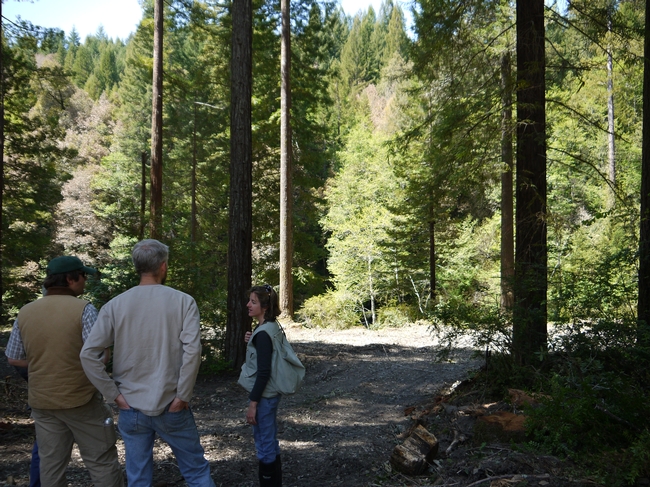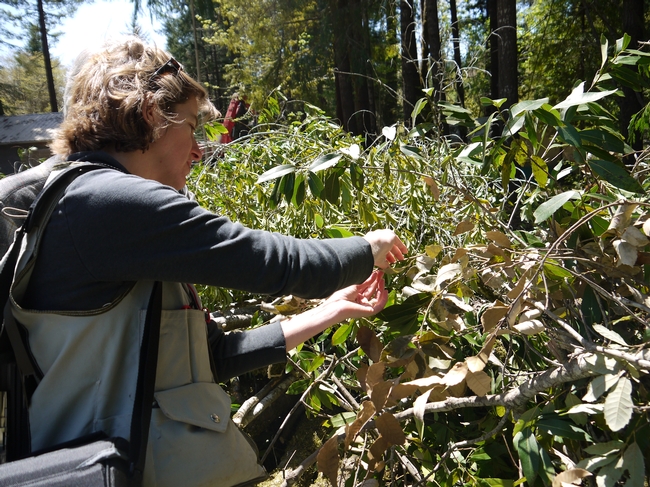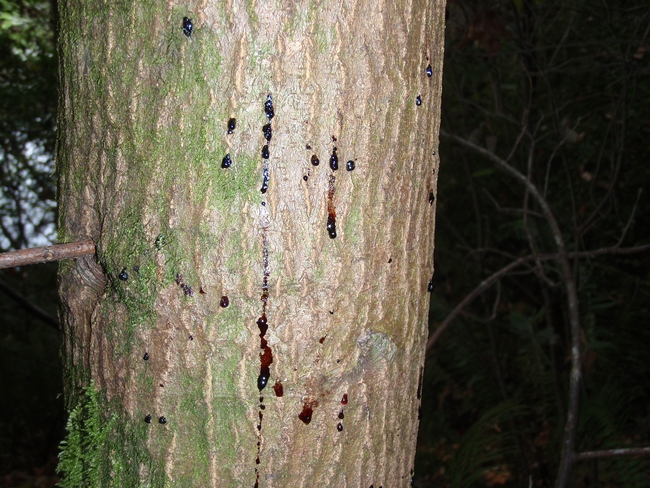
“Buy firewood from a local source close to your home to prevent the spread of insects and diseases, such as the goldspotted oak borer, sudden oak death and emerald ash borer,” said Tom Scott, a UC Cooperative Extension specialist based at UC Riverside who studies these invasive pests.
“Firewood is one of the least-regulated natural resource industries in California,” said Scott, “but this is a situation where the university can play a critical role in changing behavior through research and education rather than regulation.”
Scott and his UC Cooperative Extension colleagues are working with the U.S. Forest Service, the California Firewood Task Force and other agencies to educate and discourage woodcutters, arborists, firewood dealers and consumers from transporting infested wood.
“Many people don’t realize that firewood can harbor harmful insects and plant pathogens. Moving around infested wood can introduce those pests and pathogens to new areas where they might take hold and could have devastating impacts to trees, our natural resources and local communities,” said Don Owen, California Firewood Task Force chair and CAL FIRE forest pest specialist based in Redding.
“Even wood that looks safe can harbor destructive pests,” cautioned Janice Alexander, UC Cooperative Extension sudden oak death outreach coordinator in Marin County.
For example, female goldspotted oak borers lay eggs in cracks and crevices of oak bark, and the larvae burrow into the cambium of the tree to feed so they may not be visible.
The goldspotted oak borer has killed more than 80,000 oak trees in San Diego County in the last decade and Scott hopes it can be contained in that region. The half-inch-long beetle is native to Arizona but not to California and likely traveled in a load of infested firewood, according to Scott.
In his research, Scott has found outbreaks of goldspotted oak borer 20 miles from the infested area, which leads him to believe movement in firewood is the most likely reason for the beetle leap-frogging miles of healthy oak woodlands to end up in places like La Jolla. In communities where people harvest local trees for firewood, oaks have remained relatively beetle-free, Scott said.
In addition to concealing goldspotted oak borer, firewood may harbor other destructive invasive species such as emerald ash borer or the pathogen that causes sudden oak death. Sudden oak death has killed more than a million oak and tanoak trees in 14 coastal California counties, from Monterey to Humboldt. The highly destructive emerald ash borer has been identified in Michigan, Indiana, Ohio and Illinois, but not California.
“Our best defense against the GSOB outbreak is the enlightened self-interest of Californians purchasing firewood,” Scott added. “If you want to protect the oaks around your house, neighborhood, and nearby woodlands, make sure that you’re not buying wood that could contain these beetles.”
In a broader sense, buy firewood from reputable dealers, from local sources whenever possible – and try to make sure that the wood you buy has been properly seasoned and doesn’t contain pests.
Tips for buying oak firewood
- Don’t buy green firewood from unknown sources, it has the highest chance of containing pests and pathogens.
- Ask where the firewood originated. If it isn’t local, ask what precautions the seller has taken to ensure that the firewood is free of harmful insects and disease or consider buying from another local source.
- Wood should preferably be bark-free, or have been dried and cured for one year prior to movement.
- If you see D-shaped exit holes, be reluctant to buy unless you know the wood has dried for at least a year or longer.
For more information about the pests and diseases that threaten California’s oaks, visit these websites:


Federal and state agencies, including the USDA Forest Service, CAL FIRE and the Natural Resources Conservation Service, joined forces with UC Cooperative Extension and quickly mobilized resources to control the pathogen in Redwood Valley and halt its spread to neighboring forests. Local landowners have also played a key role.

“We’ve been closely monitoring the disease for years and anticipating a scenario like Redwood Valley, so we were ready to take action and respond quickly,” Valachovic said.
The UCCE staff leads an extensive sudden oak death monitoring program on the North Coast, and one of their detection strategies involves "leaf-baiting" in streams. Using this technique, they “bait” Phytophthora ramorum, the non-native pathogen that causes sudden oak death, by placing susceptible leaves in strategic locations in North Coast streams. If the leaf baits become infected with SOD, the scientists know that the pathogen is present in the watershed without having to comb the landscape for symptoms.
After they detected the pathogen in Redwood Creek, UCCE acted quickly to pinpoint the source of the waterborne spores, scouring the watershed for the very inconspicuous symptoms of SOD with the help and permission of public and private landowners. By November 2010, the scientists had narrowed the location to Redwood Valley, where they found dead tanoaks and several other infected host plants.

Much of the on-the-ground effort has been completed by contractors and CAL FIRE handcrews, who have created 100-meter buffers around infected trees by removing California bay laurel (pepperwood) and tanoak, the two hosts that most readily support P. ramorum spore production and spread. Infected plant material has been trucked offsite and donated to the nearby DG Fairhaven Power Company, piled and burned, or lopped and scattered onsite.
Funding from the American Recovery and Reinvestment Act, the USDA Forest Service and NRCS enabled the swift response in Redwood Valley. UCCE used ARRA funds, also known as federal stimulus funds, to hire four people to work on the project, lending stability to the effort.
Landowner support has been critical to the success of the project, according to Valachovic. More than 20 landowners in the valley have allowed monitoring and treatment activities on their properties, recognizing that their cooperation may keep the disease from spreading to other areas.
“We couldn’t just stand back and let the disease roll through the forests that we manage, and the landowners understood that,” said Dan Cohoon, who works for Eureka-based Able Forestry, which manages many of the private forestlands in the watershed.
Brandon LaPorte, manager of Cookson Ranch and one of the key landowner collaborators in Redwood Valley, has supported the project from the beginning. LaPorte explained, “We’ve learned a lot about the disease through this project, and we certainly don’t want it getting worse here on the ranch or spreading beyond the valley.”
The first phase of treatment is currently wrapping up, and UCCE is beginning to monitor project efficacy and watch for spread of the pathogen beyond project boundaries. The Yurok and Hoopa tribes will be paying close attention to this effort, as they are only a ridge away from the infestation.
Ron Reed, a Yurok tribal forester, commented, “Oaks are an important part of our culture and history, and we will do what we can to keep sudden oak death out of our forests.”
The Redwood Valley project highlights the value of stream monitoring as a detection tool for SOD, but it also demonstrates the ability of agencies and landowners to collaborate swiftly and effectively to protect the region’s forest resources. Maybe most important – regardless of the future course that sudden oak death takes in the North Coast – is what the project shows about the ability of proactive communities concerned about the health of their landscapes to come together, attract the support of state and national authorities, and work to make things better.
The community collaboration is being honored with the Two Chiefs’ Award. The award, which is given jointly by the NRCS and the Forest Service, highlights projects from across the country each year, recognizing exemplary partners who have worked collaboratively to support conservation and forest stewardship. Kathleen Merrigan, USDA deputy secretary, will present the award and Valachovic will accept the award on behalf of the federal, state, tribal and private partners involved the project at an event in Davis on Wednesday, May 16.
For more information about sudden oak death disease, visit the California Oak Mortality Task Force website at www.suddenoakdeath.org.



